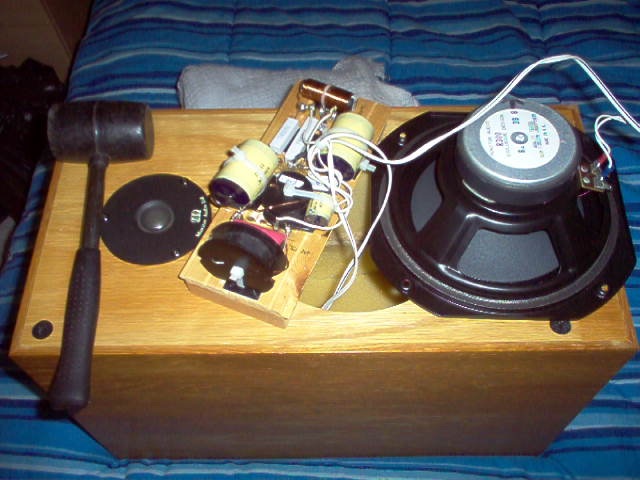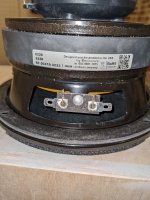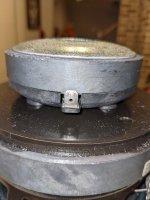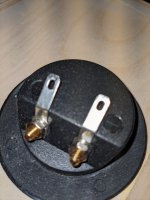Those of you with experience please recommend some Quick Connects for attaching XO wiring to driver spades and terminal cups. I have 16ga wire and need to connect to .25" and .205" spades.
Also, which crimper should I try?
Thanks
Also, which crimper should I try?
Thanks
How many crimps do you need to do?
Why?
In the sense that until it is needed to open up speaker connections, it is better to solder them, as crimps have their own issues.
A spring loaded crimper is best, but expensive, not needed for hobby or occasional use.
The plier type crimpers are a hit and miss affair.
And you must protect the joint from corrosion.
Best is to solder to the connectors, use heat shrink to cover the soldered part and a bit of the insulation on the wire.
If crimping, try and use plastic shields and heat shrink also.
Another issue with those is the alloy quality, they work loose over time, so buy good crimp connectors..
And vibration, support the wire so the joint is not loaded mechanically.
Why?
In the sense that until it is needed to open up speaker connections, it is better to solder them, as crimps have their own issues.
A spring loaded crimper is best, but expensive, not needed for hobby or occasional use.
The plier type crimpers are a hit and miss affair.
And you must protect the joint from corrosion.
Best is to solder to the connectors, use heat shrink to cover the soldered part and a bit of the insulation on the wire.
If crimping, try and use plastic shields and heat shrink also.
Another issue with those is the alloy quality, they work loose over time, so buy good crimp connectors..
And vibration, support the wire so the joint is not loaded mechanically.
Last edited:
Only use major mfr name brand lugs from a major distributor, never generic parts.
Such as: 3M, Molex, Keystone, Panduit, Phoenix.
Never mix brands for the M and F lugs, the fit may be poor.
Also use an approved, ratcheting crimp tool to install them on the wire.
Otherwise reliability will suffer.
Such as: 3M, Molex, Keystone, Panduit, Phoenix.
Never mix brands for the M and F lugs, the fit may be poor.
Also use an approved, ratcheting crimp tool to install them on the wire.
Otherwise reliability will suffer.
Last edited:
I am currently building four DIYSG Volt-6s. I need to connect my XOs to the drivers and terminal cups. The Quick Connectors I have seen at Home Depot and Lowes have the connector based on wire size. I am using 16ga wire, but have different size spades to connect to.
If I have different size spades to connect to, do I need different size wires also to get a good crimp?
This seems like it should be the simplest part of the build but is causing me the most confusion so far. I tried to crimp on some Home Depot connectors with some pliers and had poor results.
If I have different size spades to connect to, do I need different size wires also to get a good crimp?
This seems like it should be the simplest part of the build but is causing me the most confusion so far. I tried to crimp on some Home Depot connectors with some pliers and had poor results.
I was taught a trick with crimping by a fire-alarm engineer. You need to fatten up the wire ends by doubling them back quite often. Makes for a juicier connection when crimping. Obvious really.
I don't mind crimp connections.

Less enthused about back plate 4mm banana plugs and whatnot. Prefer to solder them.
I don't mind crimp connections.
Less enthused about back plate 4mm banana plugs and whatnot. Prefer to solder them.
There are crimp lugs readily available for wire as small as 22 gauge.
The wire to be crimped should not be doubled or twisted, just freshly stripped.
The wire to be crimped should not be doubled or twisted, just freshly stripped.
Have a look at the "Preciva" clones of the Knipex ratcheting crimpers. I have a pair and they are very good.
https://www.amazon.com/Thomas-Betts...ocphy=9008757&hvtargid=pla-521353036934&psc=1
One of my all time favorite tools....
One of my all time favorite tools....
Have a look at the "Preciva" clones of the Knipex ratcheting crimpers. I have a pair and they are very good.
Like this:
https://www.amazon.com/Preciva-Self...ratcheting+crimper&qid=1636396160&s=hi&sr=1-7
Unfortunately, non-ratcheting tools yield inconsistent and unreliable results.
That's a laugh !!!!
I've probably made 10,000 crimp connections with the tool i recommended, for duty far more critical than for speakers, with potential serious safety implications if failure occurred.
There's a whole lot of over-engineering going on in this thread....just saying 😉
Sorry, if anyone in my lab used a non-ratcheting tool, they would be banned from the lab.
Very poor practice, no professional engineer would do that. Doing things right is not over-engineering.
Very poor practice, no professional engineer would do that. Doing things right is not over-engineering.
Thats them. There are two types and I have both (the other is for jst, dupont, xh I think) The connectors they come with are junk. Check compatibility with the ones you want to use but I don't think I've had a bad crimp yet that wasn't down to user error.
I second the motion. I've made hundreds, if not thousands of successful crimp terminal connections. You can get an adequate crimp with a klein, Ideal, or bulldog non-ratcheting crimp tool. You calibrate yourself with the pull test. If you can't pull it off, it is going to hold. These non-racheting tools have a lot of leverage in the crimp, so even my weak hands are capable of a good crimp. My success rate is much higher on my crimps than on my solder connections. Especially on larger gauge wires. Hardware store or discount house tools shorten the handles to save cost, and are capable of good crimps only if used by goliaths. NASA JSC required the rachet terminal tools from AMP on all their installed product. I've never worked anywhere else that used them. GE final test line techs used bulldog non-racheting.That's a laugh !!!!
I've probably made 10,000 crimp connections with the tool i recommended, for duty far more critical than for speakers, with potential serious safety implications if failure occurred.
There's a whole lot of over-engineering going on in this thread....just saying 😉
Amp invented crimp terminals, now known as TE-connectivity. You can still get them at major electronic parts houses, but not in stores. Other brand terminals I respect are ideal, Thomas & betts, 3m, panduit, and the Taiwan made products of Dorman sold at auto supplies. Dorman has begun sourcing assortments of ****ese product, which are as bad as anything Radio Shack ever sold. I scored a classic car that had 30 amps of added accessories attached to the back of the ignition switch. The guy kept getting stranded when the .250 terminal burned up, with his cheapo Radio Shack terminals. I changed to T&B, no more problems.
Pink insulators are for 22-18, blue are for 16-14, yellow are for 12-10, US gauges wire. The brands above will carry above the National Electric code current rating for those wires. Crimps don't work on solid wire, only stranded.
If you have undergauge wire, say 24 ga or 26, you can double them over and make an adequate crimp in a pink barrel. Or if you're out of the right size and don't want to go to the store right now, you can double 16 or 14 in a yellow terminal (12). Different color .250" spades or .187" spades or .110" or .157" bullet connectors can plug up to each other.
I use the overall insulated ones on my electric bicycle to avoid shorts. The motor draws up to 30 amps.
I find gold plate has no advantages in circuits of 12 v over a half amp. I wired dozens of trucks & trailer lights with the tin plate connectors, in my short career as a truck mechanic.
Gold plate is useful for line-level connections like RCA plugs & jacks, that are low current and low voltage. I've had some preamp-amp cables go silent if not removed/replaced in 6 to 8 years. Speaker connections have been fine in tin.
I use tin plate crimped fork terminals for speakers under the binder turrets of my classic amps like dynakit. Other classic amps have screw terminal strips, also good with forks. Some old speakers came instead with spin nuts on screws, which work fine with bare wire if the wire is not tripped over. Other legacy PA speakers have had 1/4 phone jacks, which are not ideal especially if the switching variety. My 90's floor monitor keeps losing the tweeter or the woofer as the bi-amp speaker jacks take out the single amp drive I use. I listen on that monitor at 1 watt typically, so the tin plate switches would not be a problem at 50 watts up.
The modern speaker solution is speak-on connectors, which have internal screw terminal connections, and an external bayonet attachment which resists pulling out if the speaker cord is yanked on by a performer or roady on stage tripping over it. I bought my first pair of speak-on equipped speakers last spring. I still haven't got to use them: I need a roady to put them up on the poles (84 lb). I'm too old for that.
Pugnax, take a caliper or a finely graduated scale to measure the width of your speaker spades. Many high wattage speakers use the .250" variety, although car drivers are mostly .187". Or a quarter inch wide versus 3/16" inch.
Last edited:
For an occasional electrical worker, (not a professional technician) a ratcheting crimper is the best way to go. I always use one for marine electrical work and for any other work, including loudspeakers. A pro can get away with a non-ratcheting crimper... I do a mere hundred crimps a year, so I can not...
j.
j.
I made a recent post on this subject.
https://www.diyaudio.com/forums/multi-way/377461-spades-solder-drivers-3.html#post6808243
If a good ratcheting crimper was $150, I could understand the reluctance to use them... but I recently saw a set at the hardware store for $25. It just makes sense to use the right tool for the job.
j.
https://www.diyaudio.com/forums/multi-way/377461-spades-solder-drivers-3.html#post6808243
If a good ratcheting crimper was $150, I could understand the reluctance to use them... but I recently saw a set at the hardware store for $25. It just makes sense to use the right tool for the job.
j.
- Home
- Loudspeakers
- Multi-Way
- Recommend Quick Connects and Crimper


